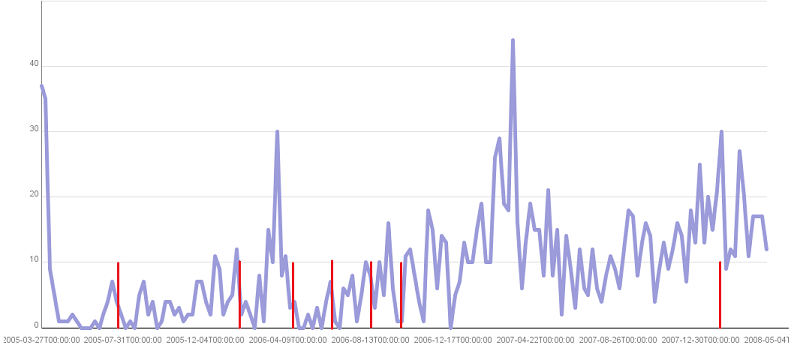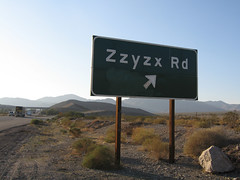 I just installed vmcNetFlix which lets you watch your on demand NetFlix movies via your Vista Media Center or any Media Center
Extenders like the Xbox 360. It works well but fails poorly with some cryptic error messages and long timeouts. Be sure to get NetFlix on demand movies working in your browser before installing
this plugin. Once I did that everything worked very well.
I just installed vmcNetFlix which lets you watch your on demand NetFlix movies via your Vista Media Center or any Media Center
Extenders like the Xbox 360. It works well but fails poorly with some cryptic error messages and long timeouts. Be sure to get NetFlix on demand movies working in your browser before installing
this plugin. Once I did that everything worked very well.
To test it out I watched Ong-Bak: The Thai Warrior in which Ting must travel from his country village to Bangkok where he works with his cousin in the city to recover his village's stolen religious artifact. Its a mix of Perfect Strangers, Street Fighter and Pad-See Ew. Martial arts movies, like porn and video games, aren't required to have a strong plot but Ong-Bak has a fine plot line and enjoyable Thai martial arts. I saw the Tiger Knee in there several times. An enjoyable movie that reminded me of watching martial arts movies with my friends in high school.
While re-reading Cryptonomicon I thought about what kind of information I'm leaking by posting links on Delicious. At work I don't post any Intranet websites for fear of revealing anything but I wondered if not posting would reveal anything. For instance, if I'm particularly busy at work might I post less indicating something about the state of the things I work on? I got an archive of my Delicious posts via the Delicious API and then ran it through a tool I made to create a couple of tables which I've graphed on Many Eyes



![[sprague's photo of Corteo in Maryland]](http://farm3.static.flickr.com/2322/2465010137_9e6f945bb0_t_d.jpg) Sarah and I went to Cirque du
Soleil's Corteo this past Wednesday. Its in Marymoor Park quite near the main Microsoft campus. They setup
large circus tents in the park including a gift shop, overpriced concession stands, and long lined porta-potties. Despite all this the show was very entertaining and quite enjoyable. The show is
like a circus directed by Terry Gilliam or Tim Schafer and otherwise I'm not sure how to describe it, but I do recommend it.
Sarah and I went to Cirque du
Soleil's Corteo this past Wednesday. Its in Marymoor Park quite near the main Microsoft campus. They setup
large circus tents in the park including a gift shop, overpriced concession stands, and long lined porta-potties. Despite all this the show was very entertaining and quite enjoyable. The show is
like a circus directed by Terry Gilliam or Tim Schafer and otherwise I'm not sure how to describe it, but I do recommend it.
![['Neverending story' by Alexandre Duret-Lutz. A framed photo of books with the droste effect applied. Licensed under creative commons.]](http://farm1.static.flickr.com/90/252757784_3de44cbeb4_m_d.jpg) Information about URI Fragments, the portion of URIs
that follow the '#' at the end and that are used to navigate within a document, is scattered throughout various documents which I usually have to hunt down. Instead I'll link to them all here.
Information about URI Fragments, the portion of URIs
that follow the '#' at the end and that are used to navigate within a document, is scattered throughout various documents which I usually have to hunt down. Instead I'll link to them all here.
Definitions. Fragments are defined in the URI RFC which states that they're used to identify a secondary resource that is related to the primary resource identified by the URI as a subset of the primary, a view of the primary, or some other resource described by the primary. The interpretation of a fragment is based on the mime type of the primary resource. Tim Berners-Lee notes that determining fragment meaning from mime type is a problem because a single URI may contain a single fragment, however over HTTP a single URI can result in the same logical resource represented in different mime types. So there's one fragment but multiple mime types and so multiple interpretations of the one fragment. The URI RFC says that if an author has a single resource available in multiple mime types then the author must ensure that the various representations of a single resource must all resolve fragments to the same logical secondary resource. Depending on which mime types you're dealing with this is either not easy or not possible.
HTTP. In HTTP when URIs are used, the fragment is not included. The General Syntax section of the HTTP standard says it uses the definitions of 'URI-reference' (which includes the fragment), 'absoluteURI', and 'relativeURI' (which don't include the fragment) from the URI RFC. However, the 'URI-reference' term doesn't actually appear in the BNF for the protocol. Accordingly the headers like 'Request-URI', 'Content-Location', 'Location', and 'Referer' which include URIs are defined with 'absoluteURI' or 'relativeURI' and don't include the fragment. This is in keeping with the original fragment definition which says that the fragment is used as a view of the original resource and consequently only needed for resolution on the client. Additionally, the URI RFC explicitly notes that not including the fragment is a privacy feature such that page authors won't be able to stop clients from viewing whatever fragments the client chooses. This seems like an odd claim given that if the author wanted to selectively restrict access to portions of documents there are other options for them like breaking out the parts of a single resource to which the author wishes to restrict access into separate resources.
HTML. In HTML, the HTML mime type RFC defines HTML's fragment use which consists of fragments referring to elements with a corresponding 'id' attribute or one of a particular set of elements with a corresponding 'name' attribute. The HTML spec discusses fragment use additionally noting that the names and ids must be unique in the document and that they must consist of only US-ASCII characters. The ID and NAME attributes are further restricted in section 6 to only consist of alphanumerics, the hyphen, period, colon, and underscore. This is a subset of the characters allowed in the URI fragment so no encoding is discussed since technically its not needed. However, practically speaking, browsers like FireFox and Internet Explorer allow for names and ids containing characters outside of the defined set including characters that must be percent-encoded to appear in a URI fragment. The interpretation of percent-encoded characters in fragments for HTML documents is not consistent across browsers (or in some cases within the same browser) especially for the percent-encoded percent.
Text. Text/plain recently got a fragment definition that allows fragments to refer to particular lines or characters within a text document. The scheme no longer includes regular expressions, which disappointed me at first, but in retrospect is probably good idea for increasing the adoption of this fragment scheme and for avoiding the potential for ubiquitous DoS via regex. One of the authors also notes this on his blog. I look forward to the day when this scheme is widely implemented.
XML. XML has the XPointer framework to define its fragment structure as noted by the XML mime type definition. XPointer consists of a general scheme that contains subschemes that identify a subset of an XML document. Its too bad such a thing wasn't adopted for URI fragments in general to solve the problem of a single resource with multiple mime type representations. I wrote more about XPointer when I worked on hacking XPointer into IE.
SVG and MPEG. Through the Media Fragments Working Group I found a couple more fragment scheme definitions. SVG's fragment scheme is defined in the SVG documentation and looks similar to XML's. MPEG has one defined but I could only find it as an ISO document "Text of ISO/IEC FCD 21000-17 MPEG-12 FID" and not as an RFC which is a little disturbing.
AJAX. AJAX websites have used fragments as an escape hatch for two issues that I've seen. The first is getting a unique URL for versions of a page that are produced on the client by script. The fragment may be changed by script without forcing the page to reload. This goes outside the rules of the standards by using HTML fragments in a fashion not called out by the HTML spec. but it does seem to be inline with the spirit of the fragment in that it is a subview of the original resource and interpretted client side. The other hack-ier use of the fragment in AJAX is for cross domain communication. The basic idea is that different frames or windows may not communicate in normal fashions if they have different domains but they can view each other's URLs and accordingly can change their own fragments in order to send a message out to those who know where to look. IMO this is not inline with the spirit of the fragment but is rather a cool hack.
 I now have search and an archive available for my site. I previously tried to setup crappy search by cheating using Yahoo Pipes and now
instead I have a slightly less crappy search that works over all of the content that I've produced on my blog, uploaded to flickr or youtube, or added to delicious.
I now have search and an archive available for my site. I previously tried to setup crappy search by cheating using Yahoo Pipes and now
instead I have a slightly less crappy search that works over all of the content that I've produced on my blog, uploaded to flickr or youtube, or added to delicious.
You can now read my first LiveJournal blog post or, for probably much more entertainment value, view all the photos and videos of Cadbury by searching for 'bunny'.
The search is only slightly less lame because although it searches over all my content, I still implemented it myself rather than getting a professional package. Also, the feed supports the same search and archive as my homepage so you can subscribe to a feed of Cadbury if you're so inclined and just skip all this other boring stuff. My homepage and feed implement the OpenSearch response elements and I've got an OpenSearch search provider (source) as well.
 This post is about creating a server side z-code
interpreter that represents game progress in the URI. Try it with the game Lost
Pig.
This post is about creating a server side z-code
interpreter that represents game progress in the URI. Try it with the game Lost
Pig.
I enjoy working on URIs and have the mug to prove it. Along those lines I've combined thoughts on URIs with interactive fiction. I have a limited amount of experience with Inform which generates Z-Code so I'll focus on pieces written in that. Of course we can already have URIs identifying the Z-Code files themselves, but I want URIs to identify my place in a piece of interactive fiction. The proper way to do this would be to give Z-Code its own mimetype and associate with that mimetype the format of a fragment that would contain the save state of user's interactive fiction session. A user would install a browser plugin that would generate URIs containing the appropriate fragment while you play the IF piece and be able to load URIs identifying Z-Code files and load the save state that appears in the fragment.
But all of that would be a lot of work, so I made a server side version that approximates this. On the Web Frotz Interpreter page, enter the URI of a Z-Code file to start a game. Enter your commands into the input text box at the bottom and you get a new URI after every command. For example, here's the beginning of Zork. I'm running a slightly modified version of the Unix version of Frotz. Baf's Guide to the IF Archive has lists of IF games to try out.
There are two issues with this thought, the first being the security issues with running arbitrary z-code and the second is the practical URI length limit of about 2K in IE. From the Z-Code standard and the Frotz source it looks like 'save' and 'restore' are the only commands that could do anything interesting outside of the Z-Code virtual machine. As for the length-limit on URIs I'm not sure that much can be done about that. I'm using a base64 encoded copy of the compressed input stream in the URI now. Switching to the actual save state might be smaller after enough user input.
 I got a FlickrMail from Emma J. Williams a bit ago saying that they wanted to
use two of my photos in their Schmap San Francisco Guide online travel guide. So now you can see two of my vacation photos on the Westfield San Francisco Shopping Center Schmap page and the Hotel Diva Schmap page.
I got a FlickrMail from Emma J. Williams a bit ago saying that they wanted to
use two of my photos in their Schmap San Francisco Guide online travel guide. So now you can see two of my vacation photos on the Westfield San Francisco Shopping Center Schmap page and the Hotel Diva Schmap page.
 I think its wonderful that digital cameras are at
the point where I really don't have to know much about their workings to produce a photo that's reasonable looking. And its thanks to Flickr and searchable tags that Schmap could find my photos.
Since my photos on Flickr are all licensed under a Creative Commons license named Attribution-Noncommercial-No Derivative Works
2.0 Generic which only applies to non-commercial uses, Schmap, which is advertisement supported, kindly asked me if they could use my photos. I agreed to their license which was human readable
and included wonderful stuff like I get in place attribution and the license is only applicable while Schmap makes their guide freely available online.
I think its wonderful that digital cameras are at
the point where I really don't have to know much about their workings to produce a photo that's reasonable looking. And its thanks to Flickr and searchable tags that Schmap could find my photos.
Since my photos on Flickr are all licensed under a Creative Commons license named Attribution-Noncommercial-No Derivative Works
2.0 Generic which only applies to non-commercial uses, Schmap, which is advertisement supported, kindly asked me if they could use my photos. I agreed to their license which was human readable
and included wonderful stuff like I get in place attribution and the license is only applicable while Schmap makes their guide freely available online.
Previously I've only heard of folks having their flickr photos used without their permission so I'm glad to know that's not always the case. Or perhaps this is just Schmap's clever method of getting me to blog about them.